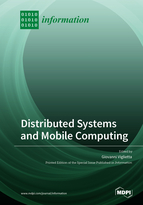Distributed Systems and Mobile Computing
A special issue of Information (ISSN 2078-2489). This special issue belongs to the section "Artificial Intelligence".
Deadline for manuscript submissions: closed (31 May 2021) | Viewed by 9777
Special Issue Editor
Interests: distributed computing; swarm robotics; computational geometry; combinatorial game theory
Special Issues, Collections and Topics in MDPI journals
Special Issue Information
Dear Colleagues,
The MDPI journal Information is inviting submissions to a Special Issue on "Distributed Systems and Mobile Computing".
Recent years have witnessed a rapid development of the field of Distributed Computing by Mobile Entities, whose concern is the study of systems of autonomous computational entities that are capable of sensing and moving within the environment they inhabit. With a great variety of applications, from swarms of mobile robots to sensor networks, from autonomous intelligent vehicles to crawlers and viruses on the Web, the theoretical research in this area intersects Distributed Computing with the fields of Computational Geometry, Graph Theory, Combinatorics, and Control Theory.
This Special Issue aims to provide a forum for the presentation and discussion of the latest theoretical and practical advances in the field of Distributed Computing by Mobile Entities.
Topics of interest may include, but are not limited to, the following:
- Models for mobile robots;
- Robot motion planning;
- Distributed graph searching;
- Mobile agents on dynamic graphs;
- Continuous protocols for swarm robotics;
- Computation under restricted visibility;
- Computing by programmable particles.
Dr. Giovanni Viglietta
Guest Editor
Manuscript Submission Information
Manuscripts should be submitted online at www.mdpi.com by registering and logging in to this website. Once you are registered, click here to go to the submission form. Manuscripts can be submitted until the deadline. All submissions that pass pre-check are peer-reviewed. Accepted papers will be published continuously in the journal (as soon as accepted) and will be listed together on the special issue website. Research articles, review articles as well as short communications are invited. For planned papers, a title and short abstract (about 100 words) can be sent to the Editorial Office for announcement on this website.
Submitted manuscripts should not have been published previously, nor be under consideration for publication elsewhere (except conference proceedings papers). All manuscripts are thoroughly refereed through a single-blind peer-review process. A guide for authors and other relevant information for submission of manuscripts is available on the Instructions for Authors page. Information is an international peer-reviewed open access monthly journal published by MDPI.
Please visit the Instructions for Authors page before submitting a manuscript. The Article Processing Charge (APC) for publication in this open access journal is 1600 CHF (Swiss Francs). Submitted papers should be well formatted and use good English. Authors may use MDPI's English editing service prior to publication or during author revisions.
Keywords
- moving and computing
- swarm robotics
- programmable particles
- mobile agents






